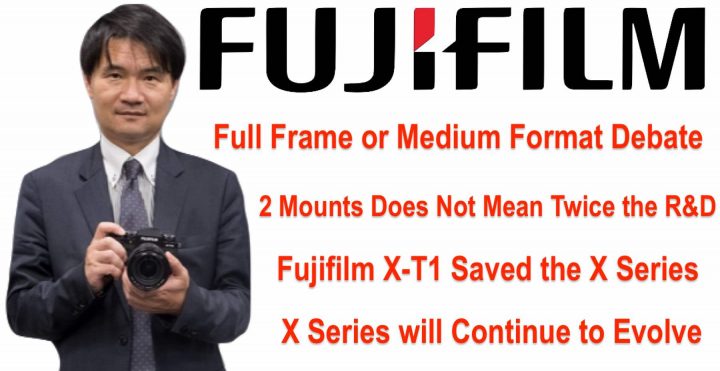Japanese Fujifilm Manager: “Long Debate if to go Full Frame or Medium Format and Fujifilm X-T1 Saved the X Series”

Japanese Fujifilm Mr. Takashi Ueno released an interview to Map Camera on youtube.
It’s all in Japanese, but the guys over at dclife provided a summary of it, which I will share down below.
- Fujifilm X-T1 was the first camera to put Fujifilm’s future stake, and luckily it sold very strong
- without Fujifilm X-T1 the manager would not make this interview today [meaning Fujifilm would not have continued the X series if the X-T1 would have failed]
- Fujifilm deliberately chose not to go full frame
- it’s not that by doubling the mounts Fujifilm would have also doubled their R&D resources. The resources remain the same
- for those who wanted larger sensors, it was not good for Fujifilm to tell those customers to look for other brands. Customers who liked the Fujifilm colors and concept. So Fujifilm decided to add the GFX system for them
- there was a long internal discussion if they should go full frame or medium format [admin note: FujiRumors has the true internal story on the moment that convinced Fujifilm to go Medium Format]
- The X series will continue to evolve
- “All camera products are the same, but the functions of cameras today are completely different from what they were 10 years ago, and I think the expectations people have for cameras are changing rapidly. On the other hand, I don’t think it’s a good thing to stay the same without changing, and I want to keep the basics in mind, but I want to evolve by properly grasping the needs of users.“.
The X-T series is the one camera that more than any other camera combined determinates Fujifilm success and future. This is why the Fujifilm X-T5 will be crucial.
- Fujifilm GFX :: The True Story About a Secret Meeting (and Test) That Convinced Fujifilm to Go Medium Format
- Good Bye, X-T1: FujiRumors Sold his Fujifilm X-T1 Today – About Love for Dials and the Story Behind my Favorite X-T1 Image
This were just the bullet points. I will also share the full Google translated part for you:
Speaking of the first camera, the “X-Pro1” is impressive, but if you say one of them, it’s the “X-T1”. After releasing the “X-Pro1”, we released the “X-E1”, “X-A1”, and “X-M1”. The X-T1 was the camera that everyone worked together as one.
In that sense, the X-T1 was a camera that was made with the future of Fujifilm’s X mount at stake. Thanks to all of you, the “X-T1” has been very well received and sales have been strong, so we are where we are today. Without the X-T1, this interview might not have happened (laughs). That’s how much the X-T1 left an impression on me.Around the time the X-T1 was released, the number of professionals and advanced amateurs using the X gradually increased, and the number of interchangeable lenses exceeded 10, making the system much more complete. Naturally, we received many requests for better image quality and larger image sensors.
Even the new APS-C format was a big challenge, but how do you get two mounts in less than five years after starting the X mount? When it comes to that, there are pros and cons within the company, and even if we deploy two mounts, our development resources will not be doubled, so resources will be halved and the (development) pace of the X series will slow down. ? Or is that going to be a minus? There were various opinions. What to do with the user’s request coming.
Up to a certain level, “X” can handle it, but beyond that, I have to say that you should use another company’s camera. This is not good for customers who say they like the colors of Fujifilm or like the concept. After all, in order to meet this need, we thought that we should launch the next line, and as a result, it led to “GFX”.
At that time, there was a long discussion whether to do “full size” or “large format”.
As a film maker, we probably know more than anyone else about the appeal and versatility of 35mm film. However, I didn’t choose to go there. Since it is digital, there is no need to drag the concept of film. Based on the idea that there is no need to drag the concept of film even though it is a film maker, even with a format that is slightly smaller than that, the image quality that surpasses the 35mm film up to that point, and in the extreme, can surpass even the brownie film that is above it. I think that the current “X” standard was chosen because of the prospect of achieving , and the technical prospects being seen, which is why the best format for digital.Thank you for your patronage and patronage of the X series for 10 years. It’s been 10 years since the launch of the X mount, and I’ve been in charge of product planning. I was able to tell you. I am very grateful.
The X series will continue to evolve. All camera products are the same, but the functions of cameras today are completely different from what they were 10 years ago, and I think the expectations people have for cameras are changing rapidly.
On the other hand, I don’t think it’s a good thing to stay the same without changing, and I want to keep the basics in mind, but I want to evolve by properly grasping the needs of users. We hope that you will continue to use the X Series to take photos, whether it be in our showrooms or at our events, and keep communicating with us. I look forward to working with you for the next 10 years. Come thank you.

